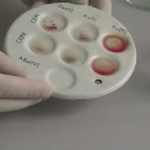 Determination of blood groups with standard sera
Determination of blood groups with standard sera
 The determination of blood groups is based on the agglutination reaction, that is, sticking together. Lumps form when both agglutinogen A and agglutinin alfa, or agglutinogen B and agglutinin beta, or both are present in the sample. Agglutinogens are found in red blood cells, and agglutinins are components of blood plasma.
The determination of blood groups is based on the agglutination reaction, that is, sticking together. Lumps form when both agglutinogen A and agglutinin alfa, or agglutinogen B and agglutinin beta, or both are present in the sample. Agglutinogens are found in red blood cells, and agglutinins are components of blood plasma.
In accordance with these signs, four blood groups are distinguished according to the AB0 system:
- I (0) - does not contain agglutinogens, only agglutinins;
- II (A) - agglutinin b, agglutinogen A;
— III (B) – agglutinin a, agglutinogen B;
- IV (AB) - contains only agglutinogens.
One of the methods for establishing a blood group is determination of blood groups according to standard sera. Standard sera contain known agglutinins: groups I, II and III. Pay attention to the photo below, maybe it will be useful to you for a better perception of the text.
procedure protocol.
Algorithm. There are three sectors.
They can be within the same plate, or they can be special holes. Sectors are signed I, II and III, each is applied with the appropriate serum. A drop of blood is squeezed out of the patient, after wiping the finger with alcohol. And they transfer drop by drop of a glass rod to the sectors with sera. Then the blood is mixed with serum until pink and the time is recorded. The reaction takes place within five minutes. It must be remembered that when working with each subsequent serum, the wand changes in order to prevent distortion of the results due to mixing of the sera. After the specified time, isotonic NaCl solution is added to the wells and mixed.
A positive result of the reaction looks like red grains formed by sticky erythrocytes, with a negative result, the mixture retains a uniform pink color. The reaction proceeds within 3-4 minutes.
Analysis of the results
Further determination of blood groups is elementary combinatorics.
If the result in three wells is negative, then this is group 0, if the reaction was only with II and I sera, then group A, only with I and III - B, and if with both - then AB. All other combinations are an artifact and indicate an incorrect analysis procedure. Errors can have different causes. The most common are the use of weak serums that have expired; carrying out an analysis with too large a drop of the patient's blood - it should be an order of magnitude smaller than the amount of serum, non-specific cold agglutination at an ambient temperature that does not correspond to normal and too long a reaction time. As the mixture dries, graininess forms at the periphery of the mixture, which should not be taken into account when assessing the blood type.
For clarity, watch this video.